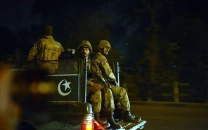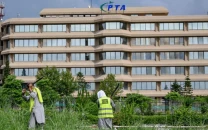Architectural heritage: In Pindi’s serpentine streets, remnants of a decaying legacy
Houses and temples in inner city present a picture of neglect.

Architectural heritage: In Pindi’s serpentine streets, remnants of a decaying legacy
The houses and temples reflect architectural characteristics of the city’s early years. Concentrated in serpentine streets, even the regrettable condition of mandirs and gurdwaras cannot hide their magnificent ornamentations.
On a heritage stroll through Rawalpindi, Prof Aziz Khan, a historian who accompanied this scribe, mused, “Dyaar-e-shauk ka abkay safar ajeeb laga, Jo ghar ko laut kay aayay tu ghar ajeeb laga.”

“Along the Leh, there were many shawalas (small temples usually built on the banks of a river for Hindu visitors). Winding through the city, the water of the Leh was once considered fit for human consumption,” recounted Prof. Khan.
“A temple dedicated to Lord Shiva behind Lal Haveli was pulled down and dug up in the hope of finding a buried treasure, said Muzammal, the owner of a general store in Bhabra Bazaar. “The same is the case of a beautiful Hindu residence nearby.”

According to Chaudhary Safdar, a former British Army soldier, Mohan Mandir in Landa Bazaar and a Sikh Gurdwara on the left once formed the heart of the surrounding localities. The head cleric of the gurdwara was a hafiz-e-Quran who used to teach Sikh children from the holy book, he said. “Mohan Mandir was constructed before my eyes.”
Kalyan Das Mandir in Kohati Bazaar has been converted into a school for the blind. “It was said to be financed by both Sikhs and Muslims, said Mubeen Ahmad, a shopkeeper.

Lakshami Narain Mandir in Purana Qila was built more than 150 years ago, said Hamid Mahmood, a trader in Zari Market, “It was attacked in 1992 in retaliation for the razing of Babri Masjid, but was saved by the administration.”
Temples in Gunjmandi and Kashmiri Bazaar have also been converted, while a gurdwara in Kiran Bazaar now accommodates eateries and embroidery shops.

“Sehgal Mandir, the biggest temple in Bhabhra Bazaar, still stands tall, even though its vast premises accommodate many families,” said Khawaja Ghulam Sadiq, a police inspector living near the mandir. The origins of other temples are shrouded in mystery.
Hindu temples everywhere share essential features, according to Prof Khan. One enters through an ornate gateway into a courtyard that leads into the heart of the temple, a smaller dark chamber called a garbhagriha, which contains the chief deity. Since Hindu worship is not fundamentally of a congregational nature, the only essential part of a temple is the shrine proper with its symbol-laden threshold and doorway, normally facing east.

In one of the narrow streets of Bhabra Bazaar stands the abandoned haveli of Rai Bahadur Soojan Singh, which was replete with courtyards. The inscriptions and paintings on the walls have been obliterated. Refugees sheltered in this house had built a wood stove in the vestibule and the smoke disfigured the richly decorated ceiling.
An entrance hall, once decorated with expensive wood, leads to the haveli’s residential quarters. The small reception area beyond it connects it with the haveli’s other sections. The western and eastern halls are distinct in form and adornment from the ceremonial halls and rooms on the first floor.
The building’s interior bore the brunt of the 1947 rampage. Built in 1893, its walls are now cracked. The rear wall has been damaged by a huge banyan tree. It is said an underground tunnel leads to Bagh Sardaran, but this may well be a myth.

Cows graze in the haveli’s garden. According to Aale Nabi Saleem, an elderly local resident, a fountain once flowed into a pool that is now gone. The physical integrity of the property has been compromised and up to 80 per cent of the structures are vulnerable.
The haveli’s decks present a panoramic view of the city. Security guards deployed by Fatima Jinnah Women University said the varsity intended to establish a library in the haveli.
Every street pulsates with a fascinating anthology of stories and nostalgic memories. Today, all these neighbourhoods, which came up during the last century, are tottering under the pressures of population, commercialisation and neglect.
The original inhabitants of the city are long gone, and with them a distinct way of life. Prof Khan, who grew up in the city, misses both but rues the loss of neither. What vexes him is the decay that has beset the city’s architectural heritage. He recited a verse form Jaun Alia, “Shehre-dil mein ajab mohallay thay, Un mein aksar naheen rahay abad.”
Published in The Express Tribune, November 28th, 2012.



















COMMENTS
Comments are moderated and generally will be posted if they are on-topic and not abusive.
For more information, please see our Comments FAQ